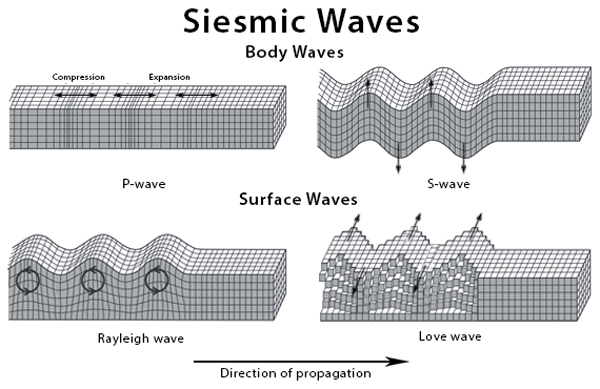Sources: Analog.com
Body Waves
As the name suggests, body waves travel through the interior of the Earth and have a frequency higher than the surface wave. Body waves are divided into P or primary and S or secondary waves. P-waves: Also called pressure waves, they can propagate in solid and liquid materials. They travel very rapidly and are the first to reach the seismograph. The motion of a P-wave is like that of a slinky. They propagate through a material by alternately compressing and expanding the medium. The motion of the particles is parallel to the direction of wave propagation. S-waves: Also called shear waves, they can only propagate in a rigid, solid material through the vibration of particles in a direction perpendicular to the propagation. Hence, they cannot propagate through a liquid. By studying the trajectories of S-waves, seismologists could prove that the Earth has a liquid outer core.
Surface Waves
Surface waves are similar to a transverse wave but travel along the boundary between the Earth’s surface and air, i.e., through the crust. They have a lower frequency than body waves. They can be easily distinguished and are responsible for the damage and destruction caused by earthquakes. The particles in a surface wave move in a circular or elliptical motion. The intensity of surface waves diminishes as they go deeper from the surface. Two common types of surface waves are Raleigh wave and Love wave. Rayleigh Waves: Named after British physicists Lord Rayleigh, who predicted its existence, the motion of Rayleigh waves is a combination of longitudinal, compressional, and dilation. As a result, the particles move elliptically in a vertical plane. These waves are dispersive, and the amplitudes generally decrease exponentially with depth in the Earth. Love Waves: Named after British mathematician A. E. H. Love, the particles of Love waves jerk back and forth perpendicular to the direction of wave propagation, similar to S-waves. The motion of particles of Love wave makes a horizontal line perpendicular to the direction of propagation. The energy of Love waves spreads from the source in two directions rather than in three. The amplitude often decreases rapidly with depth. Love waves travel faster than Rayleigh waves.
